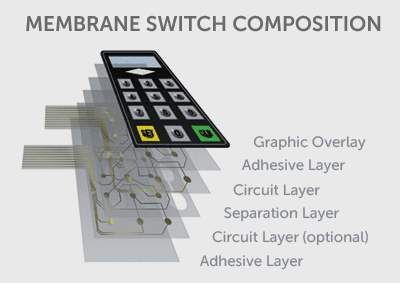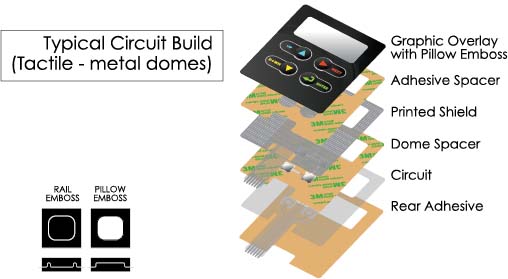Why Membrane Switches Are the Preferred Choice for Compact Devices
Why Membrane Switches Are the Preferred Choice for Compact Devices
Blog Article
Recognizing Membrane Layer Changes: The Secret to Resilient and Reliable Controls
Membrane switches represent a critical facet of contemporary user interface design, blending performance with strength in different applications. As we discover the complexities of membrane layer switches, it comes to be clear that their duty in improving control systems is both extensive and complex, elevating inquiries concerning how best to utilize their capabilities in future developments.
What Are Membrane Switches?
Membrane layer buttons are an innovative remedy in the world of customer interface technology, combining functionality and layout effortlessly. These devices work as an interface in between users and digital systems, integrating numerous parts into a small layout. Commonly built from adaptable, thin layers of products, membrane layer switches are created to react to touch, enabling individuals to engage with machinery and electronic gadgets successfully.
The main components of a membrane layer switch consist of a printed circuit layer, graphic overlay, and a spacer layer that protects against unexpected activation. The visuals overlay can be personalized to reflect brand name identity or customer preferences, boosting looks while making certain functionality. Membrane layer buttons are frequently used in various applications, including medical tools, customer electronics, and industrial tools, owing to their toughness and resistance to ecological factors such as wetness and dirt.
One of the essential benefits of membrane layer switches is their capacity to hold up against wear and tear, making them excellent for high-traffic settings. In addition, they are light-weight and need minimal area, enabling ingenious styles in product growth. Overall, membrane layer switches over stand for a efficient and useful selection for modern-day electronic interfaces, weding technology with user-centric layout principles.

Just How Membrane Switches Over Work
The operation of membrane layer switches over joints on a simple yet efficient system that equates user input into digital signals. When a customer presses the button, the leading layer flaws, enabling a conductive component in the circuit layer to make contact with an equivalent conductive pad on the bottom of the visuals overlay.
The style of membrane buttons can vary, however they often incorporate domes or responsive components to provide feedback to the customer, enhancing the overall experience. The materials utilized in membrane layer buttons, such as polyester or polycarbonate, contribute to their sturdiness and resistance to ecological factors, consisting of moisture and dust. The printed circuits are generally encapsulated, which secures them from wear and tear over time.

Benefits of Membrane Buttons
Among the main benefits of membrane layer buttons is their versatility in layout, permitting them to be customized to satisfy particular customer demands and aesthetic demands. This flexibility extends to various sectors, where various shapes, sizes, and shades can be used to boost customer interaction and aesthetic charm.
Additionally, membrane buttons are recognized for their durability. Created from robust materials, they are immune to dirt, wetness, and physical wear, which dramatically expands their life-span compared to conventional mechanical switches. This resilience makes them specifically appropriate for high-traffic atmospheres and applications requiring longevity.

In addition, membrane buttons provide a structured account, resulting in a thinner design that can be incorporated right into numerous tools without adding mass. This function not just boosts the visual appeal but additionally adds to a more ergonomic item style.

Applications of Membrane Buttons
Straightforward and versatile, membrane buttons discover applications throughout a vast array of industries, including medical tools, customer electronics, and industrial devices. In the clinical area, these switches are important to tools such as analysis equipment, patient surveillance systems, and mixture pumps, where reliability and ease of cleansing are critical. Their capacity to stand up to extreme environments and maintain functionality makes them optimal for such applications.
In customer electronic devices, membrane switches are utilized in products like microwaves, washing makers, and remotes - membrane switch. Their sleek style check that allows for user-friendly interface, improving the general customer experience while supplying toughness and resistance to deterioration
Commercial devices additionally takes advantage of membrane buttons, especially in control panels for equipment and automation systems. These switches use protection against dirt and dampness, guaranteeing consistent performance in difficult atmospheres. Their adjustable features permit makers to tailor them to certain operational demands, improving performance and capability.
Selecting the Right Membrane Layer Switch
When choosing a membrane layer button, it is necessary to consider numerous aspects that affect efficiency and viability for particular applications. The key factors to consider consist of ecological problems, responsive feedback, resilience, and layout requirements.
First, examine the operating atmosphere; buttons revealed to moisture, chemicals, or extreme temperatures call for particular materials to recommended you read make certain long life and functionality. Next off, examine the demand for responsive feedback. Depending on individual interaction, some applications might benefit from a tactile response to confirm activation, while others may prefer a non-tactile style for aesthetic factors.
Resilience is an additional essential element; membrane layer buttons must be developed to endure regular usage, influences, and abrasion. Ensure the selected button can withstand the anticipated lifecycle, specifically in high-usage circumstances.
Verdict
In verdict, membrane switches offer as essential components in the design of reliable and sturdy control systems across numerous industries. The flexibility of membrane layer switches enables for tailored services that meet certain functional needs, strengthening their relevance in modern innovation.
Membrane switches over stand for an essential element of modern-day user interface design, mixing functionality informative post with strength in different applications.Membrane switches are a sophisticated solution in the world of individual interface technology, incorporating capability and design perfectly. Typically created from adaptable, slim layers of materials, membrane buttons are developed to respond to touch, allowing individuals to engage with machinery and electronic devices efficiently.
The style of membrane layer buttons can vary, yet they often include domes or tactile aspects to provide responses to the user, improving the overall experience.In final thought, membrane layer switches over offer as important elements in the layout of long lasting and trusted control systems across numerous markets.
Report this page